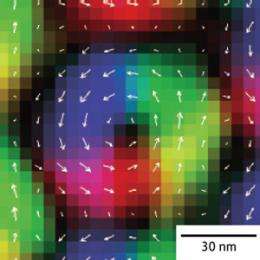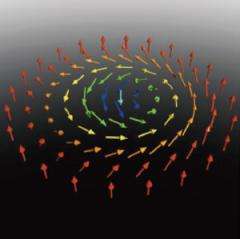First direct observation of unusual magnetic structure could lead to novel electronic, magnetic memory devices


In conventional ferromagnets, the individual magnetic moments of the atoms that together comprise the magnetism of the material are all aligned parallel, pointing in a common direction. In some magnets, quantum-mechanical interactions between the electrons of a material or the presence of internal electric fields, for example, mean that the magnetic arrangements are more complex.
Now, a rare arrangement of magnetic moments, so-called skyrmions, has been directly imaged by a team led by Yoshinori Tokura of the RIKEN Advanced Science Institute, Wako, Japan. Tokura and his colleagues from RIKEN and other research institutes in Japan and Korea confirmed that skyrmions are very stable and that their manipulation could form the basis for novel magnetic memories or electronic devices.
A skyrmion can be envisaged as a vortex-like arrangement of magnetic moments that, towards the center of the structure, increasingly twist and bend in downwards direction. In earlier experiments by other research groups, the existence of skyrmions had been inferred indirectly but efforts to image them, and to confirm their structure, failed owing to their small size with diameters of around 90 nanometers.
Tokura and his team accomplished their direct observation of skyrmions by using a Lorentz transmission electron microscope, which is suited to image magnetic structures at very high resolution. Previously, physicists considered this type of experiment impossible because observing skyrmions would require the application of external magnetic fields that they thought would disturb the imaging process of the microscope. The team realized, however, that this problem could be overcome by applying the external magnetic fields perpendicular to the imaging lens of the microscope. Tokura says that this led to the breakthrough that allowed them to show the emergence of skyrmions unambiguously.

In addition to observing the expected periodic arrangement of many skyrmions, the researchers were able to observe isolated skyrmions and establish that they are also stable entities. The manipulation of individual skyrmions could find application in novel magnetic memories or in electronic devices, Tokura notes.
Realization of such applications, however, still requires substantial work. Thus far, skyrmions have been observed only at temperatures of around 40 Kelvin. “In future, we not only need to find new materials where skyrmions are stable at room temperature, but also find ways to manipulate their motion through electromagnetic effects,” explains Tokura. He says that a number of known oxide magnetic materials could fulfill these criteria and may eventually lead to skyrmion-based devices.
More information: Yu, X. Z., Onose, Y., Kanazawa, N., Park, J, H., Han, J. H., Matsui, Y., Nagaosa, N. & Tokura, Y. Real-space observation of a two-dimensional skyrmion crystal. Nature 465, 901-904 (2010).
Provided by RIKEN




















